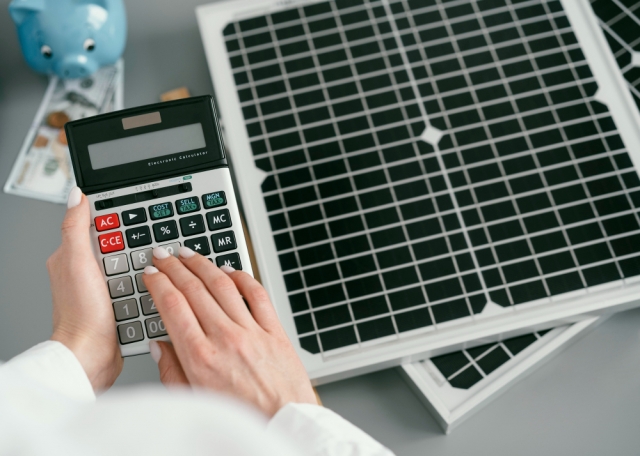Understanding the cost of solar installation is crucial before undertaking the green energy transition. The pricing varies widely, depending on several aspects including your location, the capacity of the system and incentives.
You might be surprised to find that the cost can be less daunting with the aid of federal tax credits and local incentives. With these benefits, most homeowners find the investment to be cost-effective in the long run.
To get a more precise cost estimate for your property, consider consulting with professional solar installers. They can provide you with a detailed quote based on your specific needs and conditions.
Average Solar Installation Cost
When planning to install solar panels, it's essential to understand the associated costs. Your total expense depends on several factors.
Key elements influencing the cost include the size of your home, the quantity and type of panels, and your location. But let's break this down further:
- Panels size and quantity: Larger homes require more panels which increases the cost.
- Type of solar panels: There are varying qualities and efficiencies in solar panels which also reflect in their prices.
- Installation cost: Professional installation isn't cheap but ensures the reliability and longevity of your system.
- Your location: Depending on your geographical area, you might encounter additional costs related to specific installation requirements or permits.
The average household can expect to pay between $15,000 to $25,000 for a standard solar setup. However, potential savings from tax credits and energy bills may help offset initial costs.
The exact pricing can significantly vary, so it's recommended to request quotes from multiple suppliers. Each company might offer different technologies or packages that could better fit your expectations or budget.
Solar installation might seem like a large upfront investment, but it pays off in the long run by reducing your dependence on traditional energy sources and contributing to a more sustainable environment.
Solar Panel Cost by State
The cost for installing solar panels can vary greatly depending on the state you live in. This is due to several factors like availability of sunlight, state solar incentives, and electricity rates.
While these factors can considerably affect the overall installation fee, it's reassuring that solar panel prices have seen significant decreases in recent years.
The cost to install solar has dropped by more than 40% over the last decade.
This drastic lowering of installation costs makes solar energy more affordable and attainable for homeowners across different states.
You might still be wondering about the exact amount you'll have to invest for your home. For this reason, a careful research on your state's current solar price bracket is a wise move before fully committing.
Impacting Factors on Cost
The cost of solar installation is affected by various factors. It's crucial for you to understand these factors as they significantly influence the ultimate price of your project.
Residential Profit Margin
Did you know that the average gross profit margin for residential solar projects is just over 20%? This implies that installation businesses gain a good return from such projects.
Size of Installation
The size of the installation is also a determinant in pricing. Larger installations require more solar panels, increased labor, and thus, higher costs.
Type of Solar Panels
The type of solar panels you opt for can affect costs. While monocrystalline panels offer high efficiency, they come at a premium price. Polycrystalline and thin-film panels are less expensive, but may not be as efficient.
Local Incentives and Rebates
Don't forget the role local incentives and rebates play in determining the net cost of your system. Many locales offer tax credits or rebates for installing renewable energy systems.
Installation Complexity
Your property's specifics play a part too. Difficult installation settings (steep roofs, uncommon designing spaces etc.) generally lead to higher costs due to increased labor and equipment requirements.
Detailed Solar Cost Breakdown
The current industry average cost of solar panels is between $3 to $4 per watt. You, as a potential or current homeowner, can use this information to estimate the expense of installing a solar power system on your property.
Here's a rough solar cost breakdown:
- Hardware costs: These include the price of the actual solar panels, inverter, racking, and other parts necessary for your solar power system.
- Labor costs: This includes the cost of professional installation and labor fees.
- Permitting and inspection costs: Local regulations may require that you get permits and inspections for your solar installations.
Your final solar installation costs will vary depending on a variety of factors, including the size and complexity of your project. Therefore, it is essential to do thorough research and compare quotes from different installers. This process will help you maximize value and optimize your financial investments in renewables.
The choice to invest in solar energy means committing to a sustainable future. It's not only beneficial for the environment but also for your financial portfolio in the long run.
Saving Money on Solar
Investing in solar energy is a decision that eventually pays for itself. The initial installation cost may appear high, but with numerous federal and state incentives, the prices significantly reduce. Let's delve into it further.
Solar panels cost between $15,000 and $22,500 on average before incentives for an average 2,000 square foot home. However, cost-saving options are available if you take time to explore. This is where government incentives come into play.
- Federal Investment Tax Credit: This incentive allows homeowners to deduct 26% of the cost of installing a solar energy system from federal taxes.
- State and Local Incentives: Many states offer additional incentives such as cash back, property tax exemption, and waived fees.
- Solar Renewable Energy Certificates (SRECs): In some states, homeowners generate certificates for every megawatt-hour their system produces.
- Net Metering: With this policy, you can sell excess electricity back to the grid.
Finding the balance between upfront costs and long-term savings starts with understanding these incentives. You are advised to do adequate research and consult with professionals before making your investment decision.
Solar Panel Payment Options
Looking to switch to solar? It's more affordable than ever. Thanks to technological advancements and increased competition in the market, the cost to install solar panels has significantly decreased.
According to the National Renewable Energy Laboratory (NREL), there has been a staggering 64 percent reduction in solar panel installation costs from 2010-2020.
There are several ways to finance your solar panel system. From outright purchase to leasing, each option has its pros and cons. Understanding these options is vital in choosing what's best for you.
|
Payment Option |
Pros |
Cons |
|
Outright Purchase |
You own the system and enjoy all benefits instantly. |
High upfront cost. |
|
Solar Lease |
No upfront cost and maintenance responsibilities. |
You don't own the system; limited energy savings. |
|
Solar Power Purchase Agreement (PPA) |
No upfront payment; fixed electricity rate. |
You don't own the solar system. |
|
Solar Loan |
Affordable payments; you own the system after the loan term ends. |
You're responsible for maintenance; interest payments may increase over time. |
Your choice of payment option can largely influence your overall solar installation expense. It's important to carefully consider each option before making a decision.
Solar Panel Installation Timeline
The whole-life cost of a solar installation varies widely, depending on various factors. Key among these are the power requirements of your home, local sunlight levels, and the cost of electricity in your area. These factors contribute to influencing how quickly you'll see a return on your investment.
- Initial consultation: This is where a solar professional will evaluate your home's energy needs and suitability for solar installation.
- Selection of equipment: After an evaluation has been conducted, you will work with the professionals to choose the best solar equipment for your situation.
- Installation: Following equipment selection, the actual installation process begins, generally taking between 1-3 days.
- Inspection and interconnection: Once installation is done, an inspector will review the work. After passing inspection, your new system will be connected to the grid.
- Maintenance: Solar systems generally require minimal maintenance, but regular inspections and occasional cleaning are recommended to ensure optimal performance.
Note that while prices have fallen over recent years, installing solar panels is still a significant investment. According to the Solar Energy Industries Association, an average-sized residential system has dropped from a pre-incentive price of $40,000 in 2010 to roughly $25,000 today. Thus it's critical to consider all elements of this investment before proceeding.
In any case, adopting solar energy for your home results in considerable savings in the long run. Furthermore, it greatly reduces your carbon footprint significantly contributing towards environmental conservation efforts worldwide.
Solar Cost vs Return Investment
Understanding the financial implications of solar installation involves evaluating initial costs against return on investment (ROI). The strategic balance between the two determines whether you attain a valuable or poor deal.
Solar Installation Initial Costs
The upfront cost of solar panel installation varies significantly depending on the size and complexity of your desired system. Generally, a residential solar system can cost anywhere from $15,000 to $25,000 including installation fees.
Government Subsidies and Incentives
To offset initial costs, some governments offer subsidies and incentives for households installing solar energy systems. These measures can significantly reduce your upfront expenditure.
Savings Through Solar Energy
You begin saving money as soon as your solar energy system is operational. Lower utility bills mean you start recouping your investment instantly.
Average Return on Solar Investment
Studies suggest that, on average, homeowners that go solar can expect an ROI of 20%. Specific ROI figures will vary based on factors such as location and local electricity rates.
Your Solar Investment
In terms of solar installation, you're looking at an upfront cost that varies widely but is profitable in the long run. As mentioned, factors like location, size, and incentives determine the final numbers.
However, considering the long-term savings on your energy bills, the financial viability is promising. So, get started with solar — it's a sustainable and wise investment for your financial future and the environment.
Moreover, there are multiple financing options and incentives available. They can significantly reduce your out-of-pocket expenses. So, when you calculate the cost, remember to take these into account.






